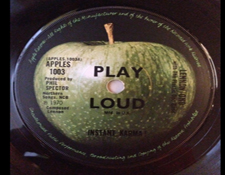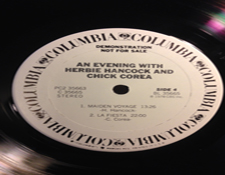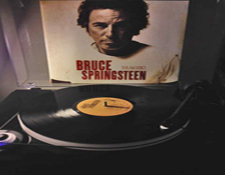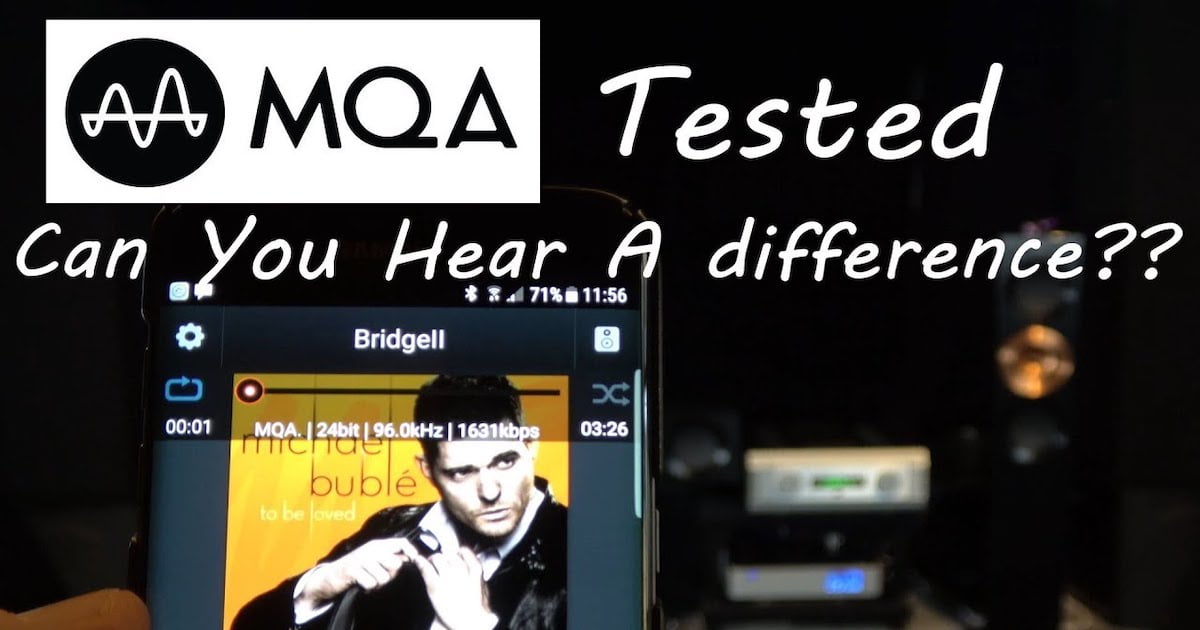It’s the time of year for saving money!
I am not sure exactly where or when I first became aware of the notion of audio compression but I’m pretty sure it was somewhere around 1980 at an odd axis of Elvis Costello, John Lennon, Herbie Hancock and Chick Corea.
 While I had owned John Lennon’s “Instant Karma” single, I’d never really paid much attention to the “Play Loud” instructions until getting a UK pressing which makes the statement much clearer than the US counterpart, in bold letters larger than even the title of the song. Then as I was getting deeper into jazz, I picked up a copy of the fine album by Herbie Hancock and Chick Corea titled simply In Concert which has a disclaimer inside the album gatefold cluing me into the challenge of time and vinyl:
While I had owned John Lennon’s “Instant Karma” single, I’d never really paid much attention to the “Play Loud” instructions until getting a UK pressing which makes the statement much clearer than the US counterpart, in bold letters larger than even the title of the song. Then as I was getting deeper into jazz, I picked up a copy of the fine album by Herbie Hancock and Chick Corea titled simply In Concert which has a disclaimer inside the album gatefold cluing me into the challenge of time and vinyl:
“Side Four is over 35 minutes long, which resulted in a slightly higher surface noise and overall lower level than could have been achieve had the tape been edited and the side made shorter. Our decision here was that it was more important to leave the medley of “Maiden Voyage” and “La Fiesta” intact than to to be concerned with slight technical deficiencies.”
Indeed the performances are great and the surface noise somewhat more apparent with the occasional little odd glitchy sound appearing now and again (I also hear some pre-echo from the magnetic tape bleeding through and imprinting itself on another part of the tape.
Details, details, details…
 When Elvis Costello’s Get Happy came out I really got much more keenly aware of the potential negative impact a mastering job could have on the recording as well as the importance of getting closer — if you will — to the source tape. I have written about this elsewhere (note: do a web search for Get Happy and my last name to locate a review of the Mobile Fidelity reissue of the album, written for another publication) but in short the US pressing of this fine album (which crams 10 songs per side of a single album) sounds like a shadow of its original UK counterpart.
When Elvis Costello’s Get Happy came out I really got much more keenly aware of the potential negative impact a mastering job could have on the recording as well as the importance of getting closer — if you will — to the source tape. I have written about this elsewhere (note: do a web search for Get Happy and my last name to locate a review of the Mobile Fidelity reissue of the album, written for another publication) but in short the US pressing of this fine album (which crams 10 songs per side of a single album) sounds like a shadow of its original UK counterpart.
I first began collecting original pressings back in the mid 70s when vinyl quality was waning (and when Capitol Records started cutting corners on their reissues, putting out Beatle records with ugly orange labels and such). So sound quality WAS in fact my original enticement for getting the good stuff on vinyl…
Later I learned of the challenges made in the making of some albums due to time constraints, such as Todd Rundgren’s Initiation (in which Side Two clocks in over 35 minutes); Todd has expressed his feelings in interviews about vinyl and its physical downside for longer form artists such as himself, lamenting the sonic compromises that often need to made in creating the LP, especially as the album reaches the center of the disc (volume, dynamic range).
Still for the most part when you play those records louder they sound more or less good. Noisey at times but the music is there. Dynamic range ‘n all that mostly in tact.
 Which brings me to a recent acquisition that I had higher hopes for: Bruce Springsteen’s Magic. This 2007 album was released to both applause and dismay from fans and audio enthusiasts alike. Claiming myself as both, I can attest to the frustration of hearing this fine record — which contains some of Bruce’s best music since his late 70s/early 80s heyday — which also sounds (to be kind) somewhat on the harsh side. I have scoured several online forums and looked for details on the web as to the reasons for why this album sounds the way it does. Everyone is an expert and everyone has a theory but nowhere have I found any specifics as to the result of the sound.
Which brings me to a recent acquisition that I had higher hopes for: Bruce Springsteen’s Magic. This 2007 album was released to both applause and dismay from fans and audio enthusiasts alike. Claiming myself as both, I can attest to the frustration of hearing this fine record — which contains some of Bruce’s best music since his late 70s/early 80s heyday — which also sounds (to be kind) somewhat on the harsh side. I have scoured several online forums and looked for details on the web as to the reasons for why this album sounds the way it does. Everyone is an expert and everyone has a theory but nowhere have I found any specifics as to the result of the sound.
I don’t have the answers but I will off this bit of detail from listening to the vinyl version of Magic which I just purchased recently (been looking for a copy for sometime): it sounds better when you turn it up loud!
Play Loud, the mantra of rock ‘n roll… maybe, just maybe, there is something to it. I’m not saying this is the answer, folks. I’m just trying to find some light at the end of this seemingly dark tunnel.
]]> Sure the CD sounds hella harsh (as the kids might say) and I’m not going to get into the issues of “brick walling” and such which audio geeks like us have discussed to death all over the Interweb.
Admittedly, the first thing I noticed when I put on the LP is that it sounded muted, dark and murky even, which was odd since the CD is so painfully bright. Then I made a simple discovery: I turned up the volume and — voila! — there was the recording! There is much more bass on the LP, perhaps too much (but that is still better than the CD so I’m not complaining there!).
Sure, there is a certain sonic texture to this album that I suspect has more to do with the processors used in making the album than purely compression elements. Aural exciters or whatever the effect du jour may have been in 2007 when this was made. Whether one likes the sonic flavor of the record is a matter of taste and personal preference. I do know that I find it a whole lot easier to enjoy this music played off the LP version than the CD — my inner digital red flag does not go off horribly as it does when listening to the CD.
Which got me thinking again about other things that might be contributing to this disparity — its never just one thing. So, consider that that there is a bunch of (what must have been at one point) pretty dynamic music crammed on to this single disc (11 songs). Now take into account that on Bruce’s other recent records (Devils ‘n Dirt, Seeger Sessions, Wrecking Ball, etc.) he has a similar number of tracks spread over two LPs, giving the disc mastering engineer more room to open up things when creating the actual disc.
To that, and to my ear, curiously, that thing that Todd has discussed — essentially the need to reduce volume and dynamic range as the record nears the center — may actually be working to the benefit of the music on Magic. So the album actually starts to sound better as it moves along, with tracks like “Girls In Their Summer Clothes” actually sounding pretty good in all its Spector-Meets-Wilson-esque glory.
It is a different sound here, for sure — and I suspect it largely is the sound of current style mainstream radio — but the music ultimately prevails. And until we get a newly remixed and/or remastered version of Magic spread out over two LPs and/or a high resolution download, this will have to suffice.
After I got done listening to Magic several times on LP, I decided to clear my ears a bit and put on an actual Phil Spector produced record (He’s A Rebel by The Crystals, reissue on Sundazed Records). And you know what I hear? I hear a connection between that vintage music which was designed to be played out of a single three-inch transistor radio speaker and Bruce’s Magic.
Sure the CD sounds hella harsh (as the kids might say) and I’m not going to get into the issues of “brick walling” and such which audio geeks like us have discussed to death all over the Interweb.
Admittedly, the first thing I noticed when I put on the LP is that it sounded muted, dark and murky even, which was odd since the CD is so painfully bright. Then I made a simple discovery: I turned up the volume and — voila! — there was the recording! There is much more bass on the LP, perhaps too much (but that is still better than the CD so I’m not complaining there!).
Sure, there is a certain sonic texture to this album that I suspect has more to do with the processors used in making the album than purely compression elements. Aural exciters or whatever the effect du jour may have been in 2007 when this was made. Whether one likes the sonic flavor of the record is a matter of taste and personal preference. I do know that I find it a whole lot easier to enjoy this music played off the LP version than the CD — my inner digital red flag does not go off horribly as it does when listening to the CD.
Which got me thinking again about other things that might be contributing to this disparity — its never just one thing. So, consider that that there is a bunch of (what must have been at one point) pretty dynamic music crammed on to this single disc (11 songs). Now take into account that on Bruce’s other recent records (Devils ‘n Dirt, Seeger Sessions, Wrecking Ball, etc.) he has a similar number of tracks spread over two LPs, giving the disc mastering engineer more room to open up things when creating the actual disc.
To that, and to my ear, curiously, that thing that Todd has discussed — essentially the need to reduce volume and dynamic range as the record nears the center — may actually be working to the benefit of the music on Magic. So the album actually starts to sound better as it moves along, with tracks like “Girls In Their Summer Clothes” actually sounding pretty good in all its Spector-Meets-Wilson-esque glory.
It is a different sound here, for sure — and I suspect it largely is the sound of current style mainstream radio — but the music ultimately prevails. And until we get a newly remixed and/or remastered version of Magic spread out over two LPs and/or a high resolution download, this will have to suffice.
After I got done listening to Magic several times on LP, I decided to clear my ears a bit and put on an actual Phil Spector produced record (He’s A Rebel by The Crystals, reissue on Sundazed Records). And you know what I hear? I hear a connection between that vintage music which was designed to be played out of a single three-inch transistor radio speaker and Bruce’s Magic.
 Indeed, the magic is ultimately in the music. There is not a lot of bass on the Spector album despite its very dense production sensibility. That style of re
cording is one that aims to find a balance between letting you hear the vocals while allowing certain instruments to pop through the mix at key times, be it a string section or castanets or an acoustic guitar strumming while an electric guitar plays in the background warbling with proto-surf vibrato.
Once again, these are productions that sound extra great turned up loud.
So maybe there is something to that notion in finding the magic tucked away in the grooves. Play Loud!
I’ll leave that up to you to decide. We all have different ears, different sound systems and different ways we like to listen.
As a friend of mine likes to say at times like this: “it is what it is…”
Play Loud!
Mark Smotroff is a freelance writer and avid music collector who has worked for many years in marketing communications for the consumer electronics, pro audio and video games industries, serving clients including DTS, Sega, Sony, Sharp, AT&T and many others. www.smotroff.com Mark has written for EQ Magazine, Mix Magazine, Goldmine/DISCoveries Magazine, BigPictureBigSound.com, Sound+Vision Magazine and HomeTechTell.com. He is also a musician / composer whose songs have been used in TV shows such as Smallville and Men In Trees as well as films and documentaries. www.ingdom.com Mark is currently rolling out a new musical he’s written: www.dialthemusical.com.
Indeed, the magic is ultimately in the music. There is not a lot of bass on the Spector album despite its very dense production sensibility. That style of re
cording is one that aims to find a balance between letting you hear the vocals while allowing certain instruments to pop through the mix at key times, be it a string section or castanets or an acoustic guitar strumming while an electric guitar plays in the background warbling with proto-surf vibrato.
Once again, these are productions that sound extra great turned up loud.
So maybe there is something to that notion in finding the magic tucked away in the grooves. Play Loud!
I’ll leave that up to you to decide. We all have different ears, different sound systems and different ways we like to listen.
As a friend of mine likes to say at times like this: “it is what it is…”
Play Loud!
Mark Smotroff is a freelance writer and avid music collector who has worked for many years in marketing communications for the consumer electronics, pro audio and video games industries, serving clients including DTS, Sega, Sony, Sharp, AT&T and many others. www.smotroff.com Mark has written for EQ Magazine, Mix Magazine, Goldmine/DISCoveries Magazine, BigPictureBigSound.com, Sound+Vision Magazine and HomeTechTell.com. He is also a musician / composer whose songs have been used in TV shows such as Smallville and Men In Trees as well as films and documentaries. www.ingdom.com Mark is currently rolling out a new musical he’s written: www.dialthemusical.com.






